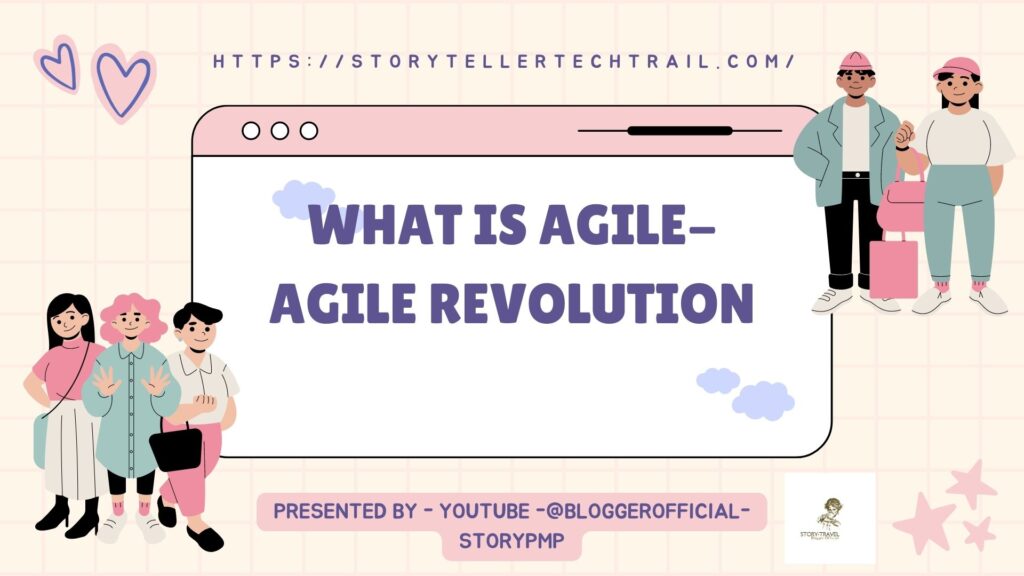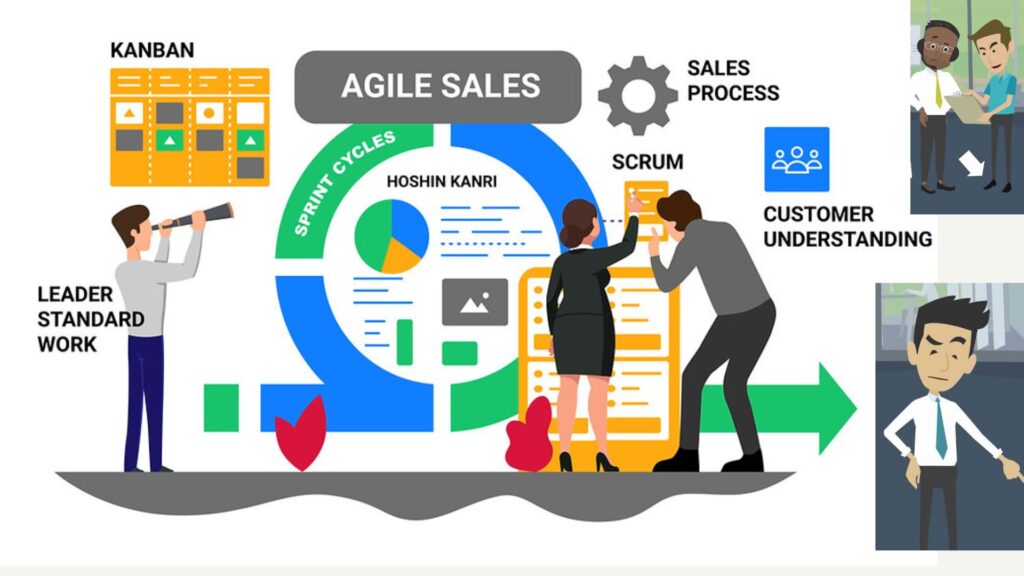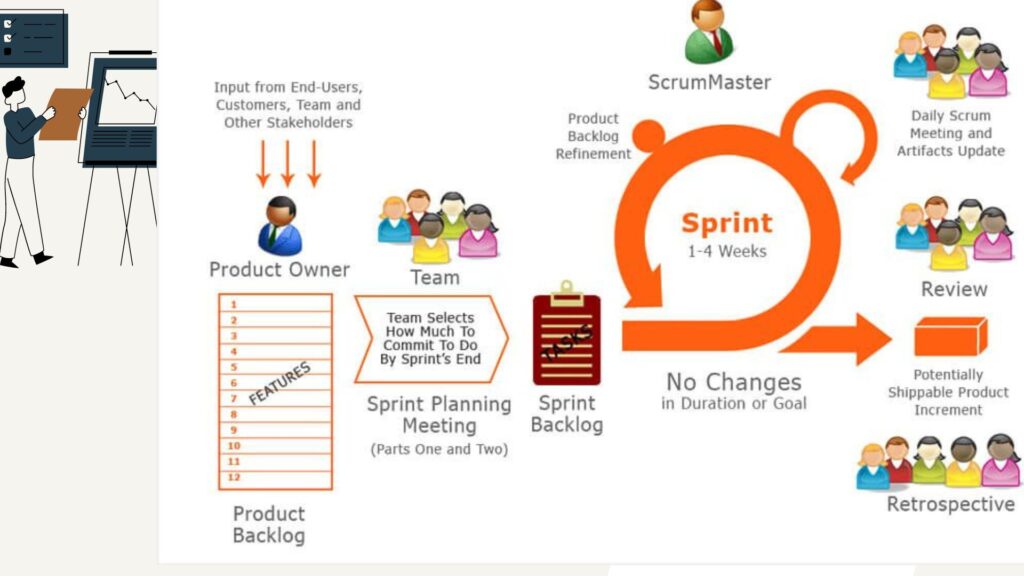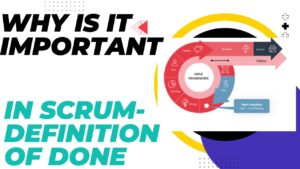Table of Contents
Introduction:
Agile Methodology, In today’s dynamic and rapidly changing business landscape, traditional project management approaches often struggle to keep pace with the demands of modern projects. As organizations strive for increased efficiency, quicker delivery, and enhanced collaboration, the Agile methodology has emerged as a transformative solution. Agile, with its emphasis on flexibility, iterative progress, and customer-centricity, offers a refreshing departure from the rigid methodologies of the past. In this comprehensive guide, we will delve into the core concepts of Agile methodology, explore its evolution from traditional project management practices, and uncover the compelling need that drives its widespread adoption.

The Evolution of Project Management:
Project management practices have evolved over the years, from traditional Waterfall methods to the more contemporary Agile approach. The Waterfall model, characterized by sequential phases, rigid planning, and limited flexibility, dominated the scene for decades. However, its limitations in accommodating changes and engaging stakeholders effectively led to the emergence of Agile Methodology.
Agile Methodology, in contrast, was conceived in response to the shortcomings of the Waterfall model. It took shape in the 1990s as a solution to the dynamic nature of software development and the need for more customer-centric approaches. Agile Methodology- The Agile Manifesto, a pivotal document in Agile’s history, was formulated in 2001 by a group of software developers who sought a more flexible and collaborative way to manage projects.
Traditional Project Management vs. Agile Methodology Revolution
Project management has undergone a remarkable evolution over the years, transitioning from linear and inflexible approaches to the more adaptive and responsive Agile Methodology we witness today. Traditional project management, often characterized by its waterfall model, followed a sequential process where each phase depended on the completion of the previous one. However, as projects grew in complexity and business environments became more volatile, this linear approach began to reveal limitations:
- Lack of Flexibility: Changes or adjustments mid-project were cumbersome and costly.
- Limited Customer Involvement: Stakeholder feedback was often sought at the end of the project lifecycle.
- Inefficient Risk Management: Risks were addressed late in the process, leading to potential setbacks.
Example: Consider a software development project using the waterfall approach. The team completes the entire coding phase before realizing that the user requirements have shifted, necessitating significant rework and delaying the project.
The Need for Agile Methodology:
Agile Methodology addresses the challenges posed by traditional project management approaches, such as the Waterfall model, which often result in delayed deliveries, scope changes, and insufficient client involvement. Agile’s fundamental principles align more closely with the realities of modern project demands, encouraging adaptability, constant feedback loops, and client engagement. This need for Agile arises from several key factors:
- Changing Requirements: In dynamic industries, project requirements can evolve rapidly, making it essential to have a methodology that can accommodate these changes seamlessly.
- Customer-Centric Approach: Agile places the customer at the heart of the project, ensuring their needs are met throughout the development process.
- Faster Time-to-Market: Agile’s iterative nature allows for quicker delivery of functional components, enabling products to reach the market sooner.
- Collaborative Teams: Agile emphasizes cross-functional collaboration, harnessing the diverse skills of team members to optimize outcomes.
Navigating the Modern Project Landscape with Agile Methodology
Agile Methodology -The shortcomings of traditional project management paved the way for the Agile methodology, which was developed in response to the growing need for more adaptive and customer-focused approaches. Agile methodology introduces a set of guiding principles that prioritize collaboration, incremental progress, and constant feedback loops. Agile Methodology, this approach recognizes that in today’s fast-paced world, businesses require the ability to pivot swiftly and respond to changing market dynamics. The following factors underline the compelling need for Agile methodology:

- Rapid Market Changes: Industries experience frequent shifts, demanding projects that can swiftly adapt to new requirements.
- Enhanced Customer Engagement: Agile encourages continuous customer involvement, leading to products that better meet user needs.
- Iterative Development: Projects are broken down into smaller, manageable iterations that deliver value in shorter cycles.
Example: Imagine an e-commerce platform aiming to revamp its user interface. By adopting Agile methodology, the development team can release updated interface elements in iterative phases, ensuring that user feedback is continually integrated, resulting in an interface that aligns closely with customer preferences.
By embracing Agile Methodology, project managers can address the dynamic demands of today’s projects while fostering collaboration, adaptability, and iterative progress. This approach’s evolution and significance pave the way for a more effective and responsive project management paradigm.
Understanding Agile Methodology:
Agile Methodology is a dynamic and iterative approach to project management that prioritizes flexibility, collaboration, and customer satisfaction. It emerged as a response to the limitations of traditional, linear project management methods like the Waterfall model. Agile embraces change and encourages continuous improvement throughout the project lifecycle.
Definition and Core Principles:
At its essence, Agile Methodology is a project management approach that values adaptability, collaboration, and customer satisfaction above all. It shuns the rigidity of traditional methods and embraces change as a natural part of the development process. The core principles that underpin Agile include:
- Iterative Development: Agile projects are broken down into smaller iterations in Agile Methodology, or “sprints,” each delivering a functional piece of the final product. This approach allows for incremental progress and regular opportunities for feedback and adjustment.
- Customer Collaboration: Agile prioritizes frequent and meaningful interaction with customers, end-users, and stakeholders. This collaboration ensures that the project stays aligned with real-time needs and expectations.
- Embracing Change: Instead of fearing change, Agile Methodology welcomes it. Changes in requirements, priorities, or market conditions are expected and integrated into the development process.
- Self-Organizing Teams: Agile teams are empowered to make decisions and plan their work. Agile Methodology This autonomy fosters creativity, ownership, and a sense of responsibility among team members.
- Continuous Improvement: Regular reflection and adaptation are fundamental to Agile Methodology. Through frequent retrospectives, teams identify areas for improvement and refine their processes over time.
Agile Manifesto: Values and Principles:
The Agile Manifesto, a cornerstone of Agile Methodology, was established in 2001 by a group of software developers who recognized the need for a more responsive and customer-centric approach to project management. The Manifesto outlines four core values and twelve principles that guide Agile practices:
Agile Manifesto Values: Agile Methodology
- Individuals and Interactions over Processes and Tools: Emphasizes the importance of effective communication and collaboration among team members and stakeholders.
- Working Solutions over Comprehensive Documentation: Prioritizes delivering functional solutions that provide value to customers and end-users.
- Customer Collaboration over Contract Negotiation: Advocates involving customers and stakeholders in the development process to ensure alignment with their needs.
- Responding to Change over Following a Plan: Acknowledges the need to adapt and adjust based on feedback and changing circumstances.
Agile Principles: Agile Methodology
- Prioritize customer satisfaction through continuous delivery of valuable software.
- Welcome changing requirements, even late in development.
- Deliver working software frequently, with a preference for shorter timescales.
- Collaborate closely between developers and stakeholders throughout the project.
- Build projects around motivated individuals and give them the support they need.
- Use face-to-face communication as the most efficient and effective means of conveying information.
- Measure progress primarily through functional software.
- Maintain a sustainable pace of work for the team.
- Strive for technical excellence and good design.
- Keep things simple and focus on what’s necessary.
- Allow self-organizing teams to make decisions and adapt as needed.
- Reflect regularly on the team’s performance and adjust accordingly.
Example: Consider a project to develop an e-commerce website. In a traditional Waterfall approach, a detailed plan would be established upfront, and any changes would be met with resistance. In Agile Methodology, however, the team would work in short sprints, delivering functional features regularly. If the market demands a new payment gateway mid-project, Agile Methodology embraces this change and ensures the website remains responsive to evolving customer needs.
By comprehending the essence of Agile Methodology, its principles, and the guiding Agile Methodology, Agile Manifesto, teams can harness its power to drive collaborative, adaptable, and customer-focused project management.
Key Concepts of Agile:
Agile Methodology introduces a set of fundamental concepts that redefine how projects are planned, executed, and delivered. These concepts serve as the building blocks for Agile’s success in fostering flexibility, adaptability, and customer value. This section explores two pivotal concepts: Iterative and Incremental development and Cross-functional teams, along with their respective roles and responsibilities.
Iterative and Incremental Development:
At the heart of Agile Methodology lies the concept of iterative and incremental development. This approach challenges the traditional linear thinking of project management by breaking down the development process into smaller, manageable cycles. These cycles, known as iterations or sprints, encompass all aspects of the development process: planning, design, implementation, testing, and delivery. Iterative development offers several benefits:
- Frequent Feedback: Each iteration results in a working product increment, allowing stakeholders to provide feedback early and regularly.
- Adaptability: Agile teams can adjust the product’s direction based on feedback and changing requirements without derailing the entire project.
- Reduced Risk: Smaller iterations mitigate the risk of major failures and allow for course correction before significant resources are invested.
- Continuous Improvement: Lessons learned from each iteration inform subsequent ones, leading to a more refined end product.
Example: Imagine a software development project for a new mobile app. Instead of trying to build the entire app in one go, Agile divides the project into iterations. In the first iteration, the team focuses on creating the app’s basic structure and navigation. Subsequent iterations add features like user authentication, payment processing, and user feedback. At the end of each iteration, a functional component of the app is ready, enabling the team to gather user feedback and refine their approach.
Agile projects, Agile Methodology embrace Iterative and Incremental Development as a strategic approach to building and refining software and products over time.
- Iterative Approach: Agile projects are divided into short iterations or cycles, each producing a working version of the product. After each iteration, the product is reviewed, and feedback is gathered from stakeholders. This iterative process allows for continuous improvements and adjustments based on real-world insights.
- Incremental Approach: Instead of attempting to deliver the entire project in one go, Agile breaks it down into smaller, manageable increments. Each increment adds new features or functionalities to the product, ensuring that value is continuously delivered to customers.
Example: Imagine an Agile team developing a mobile app for a fitness tracker. In the first iteration, they create the basic user interface and allow users to log their daily steps. After gathering feedback, the second iteration adds features like calorie tracking, and subsequent iterations introduce more functionalities such as heart rate monitoring and workout tracking. This iterative and incremental approach ensures that the app remains responsive to user needs and market trends.
Cross-functional Teams: Roles and Responsibilities:
In Agile, Agile Methodology the concept of cross-functional teams revolutionizes collaboration. These teams consist of individuals with diverse skills and expertise required to take a project from conception to completion. Each member contributes unique talents, fostering a sense of shared ownership and collective accountability. Roles within a cross-functional team include:
- Roles and Responsibilities:
- Product Owner: Represents the customer and stakeholders, defines product features, prioritizes the product backlog, and ensures that the team is delivering value.
- Scrum Master: Facilitates the Agile process, removes obstacles, and ensures that the team adheres to Agile principles and practices.
- Development Team: Comprises skilled individuals responsible for designing, coding, testing, and delivering product increments. Team members work collaboratively to achieve the Sprint goals.
- Advantages of Cross-functional Teams:
- Collaborative Problem-solving: Cross-functional teams bring diverse perspectives and skills to the table, enabling comprehensive problem-solving and innovation.
- Reduced Dependencies: With all necessary skills present in the team, there’s less reliance on external resources or departments, streamlining the development process.
- Faster Decision-making: Decisions can be made more swiftly within the team, reducing delays and bottlenecks.
Example: In a marketing campaign project, a cross-functional Agile team may consist of a Product Owner from the marketing department, a Scrum Master with project management expertise, and developers, designers, content creators, and analysts. Together, they collaboratively plan, execute, and adapt the campaign, ensuring a comprehensive and well-coordinated effort.
By grasping the concepts of Iterative and Incremental Development and Cross-functional Teams, project teams can unlock the true potential of Agile Methodology, driving iterative progress, fostering collaboration, and delivering customer-centric value.
Agile Frameworks:Agile Methodology
Agile Methodology offers a range of frameworks that serve as structured guides for implementing Agile principles in project management. These frameworks provide adaptable structures that cater to various project needs and team dynamics. Here, we explore three prominent Agile frameworks: Scrum, Kanban, and Lean.

Scrum:
Scrum is one of the most widely used Agile frameworks, Agile Methodology known for its structured yet flexible approach. It divides the project into iterative cycles called sprints, each typically lasting two to four weeks. Scrum emphasizes collaboration, adaptability, and continuous improvement through its distinct components:
- Scrum Roles:
- Product Owner: Represents stakeholders and defines project goals, priorities, and features.
- Scrum Master: Facilitates the Scrum process, removes obstacles, and ensures adherence to Agile principles.
- Development Team: Cross-functional group responsible for turning requirements into a functional increment.
- Scrum Artifacts:
- Product Backlog: A dynamic list of features, enhancements, and bug fixes prioritized by the product owner.
- Sprint Backlog: A subset of the product backlog, containing items to be completed in the current sprint.
- Increment: The sum of all completed sprint backlog items, representing a potentially shippable product component.
- Scrum Events:
- Sprint Planning: The team plans the work for the upcoming sprint, selecting items from the product backlog.
- Daily Standup: Brief daily meetings where team members share progress, challenges, and plans.
- Sprint Review: The team presents the completed increment to stakeholders and gathers feedback.
- Sprint Retrospective: A reflection session where the team identifies improvements for the next sprint.
Kanban:
Kanban, inspired by lean manufacturing principles, is an Agile framework that focuses on visualizing work, limiting work in progress (WIP), and optimizing flow. Kanban emphasizes continuous delivery and adaptability. Key concepts of Kanban include:
- Visualizing Workflow: Kanban visualizes work items on a board, categorizing them into stages or columns. This provides transparency into the progress of tasks and identifies potential bottlenecks.
- Work-in-Progress (WIP) Limits: Kanban introduces limits on the number of tasks that can be in progress at any given time. This prevents overloading the team and maintains a steady flow of work.
- Continuous Improvement: Kanban encourages teams to regularly assess their processes and make incremental improvements to enhance efficiency and value delivery.
Lean:
Lean principles focus on optimizing value delivery while minimizing waste. Derived from the Toyota Production System, Lean is not limited to software development but can be applied to various industries. Key aspects of Lean include:
- Reducing Waste: Lean identifies various types of waste, including overproduction, defects, waiting, and unnecessary processes. The goal is to eliminate these inefficiencies to enhance value.
- Optimizing Value: Lean emphasizes delivering value that aligns with customer needs while minimizing unnecessary features or steps.
- Continuous Improvement: Similar to Agile’s principles, Lean promotes ongoing reflection and improvement to enhance processes and outcomes.
Example: Imagine a software development project using the Scrum framework. The product owner creates a product backlog, including features requested by stakeholders. The development team holds sprint planning, selecting items from the backlog for a two-week sprint. During daily standups, team members discuss their progress and challenges. At the end of the sprint, the team presents the completed increment during the sprint review. In the sprint retrospective, they identify areas for improvement and adjust their approach for the next sprint.
By embracing frameworks like Scrum, Kanban, and Lean, teams can tailor their Agile practices to suit their project’s unique requirements, fostering collaboration, adaptability, and value delivery.
The Agile Process:
The Agile process is a dynamic and iterative approach to project management that emphasizes collaboration, adaptability, and continuous improvement. This section outlines the key stages of the Agile process, from capturing user requirements to fostering learning and enhancement through retrospectives.
User Stories: Capturing User Requirements:
User stories are the building blocks of Agile projects, representing succinct descriptions of specific features or functionalities from a user’s perspective. These stories capture the “what” and the “why” of a feature, helping teams understand user needs and prioritize work. Key aspects of user stories include:

- Role: Identify the user or stakeholder for whom the feature is being developed.
- Feature: Describe the specific functionality or capability required.
- Benefit: Explain the value or benefit the user will derive from the feature.
Example: A user story for a social media app might read: “As a user, I want to be able to upload photos directly from my device to share with my friends, so I can easily share moments with my social network.”
Sprint Planning: Setting Goals and Priorities:
Sprint planning is a crucial phase where the Agile team collaborates to define the goals and scope of the upcoming sprint. This involves selecting user stories from the product backlog and estimating the effort required for each. Key elements of sprint planning include:
- Backlog Refinement: Review and prioritize user stories based on value, complexity, and dependencies.
- Sprint Goal: Define the overarching objective of the sprint, outlining what the team aims to accomplish.
- Task Breakdown: Break down selected user stories into smaller tasks or sub-tasks, estimating the effort for each.
Sprint Execution: Daily Standup and Collaborative Work:
During the sprint, the team works collaboratively to complete the tasks identified in the sprint planning. Daily standup meetings are held to foster communication and alignment among team members. Key aspects of sprint execution include:
- Daily Standup: Short daily meetings where team members share progress, discuss challenges, and plan their work for the day.
- Collaboration: Team members collaborate to implement user stories, addressing any obstacles or issues that arise.
Sprint Review: Demonstrating Progress to Stakeholders:
At the end of each sprint, a sprint review is held to showcase the completed work to stakeholders. This provides an opportunity for feedback and alignment with project goals. Key aspects of the sprint review include:
- Demo: Present the completed user stories and features to stakeholders, demonstrating the functionality.
- Feedback: Gather feedback from stakeholders and incorporate their input into future iterations.
Sprint Retrospective: Learning and Continuous Improvement:
Following the sprint review, the team engages in a retrospective to reflect on the sprint’s successes and challenges. This retrospective informs process improvements for the next sprint. Key elements of the sprint retrospective include:
- Review: Evaluate the sprint’s outcomes, celebrating achievements and discussing areas for improvement.
- Identify Improvements: Identify specific actions or adjustments that can enhance team performance and processes.
Example: In a sprint retrospective, the team may identify that communication breakdowns hindered progress. As a result, they decide to implement daily cross-functional meetings to ensure better alignment and collaboration.
By following these stages of the Agile process, teams can create a collaborative, adaptable, and value-driven approach to project management, fostering ongoing learning and improvement.
Benefits of Agile Methodology:
Agile Methodology offers a range of advantages that propel projects towards success, aligning with the ever-changing landscape of modern business. This section highlights key benefits that organizations can harness by embracing Agile practices.
Flexibility and Adaptability:
Agile’s emphasis on adaptability is a cornerstone of its success. Agile teams are equipped to respond swiftly to changes in requirements, technology, or market conditions. By breaking projects into manageable iterations, Agile allows for regular reassessment and adjustment, enabling teams to pivot and address emerging challenges effectively. This flexibility empowers teams to seize opportunities and deliver solutions that remain aligned with evolving business needs.
Faster Time-to-Market:
Agile’s iterative approach facilitates accelerated delivery of functional increments. By focusing on delivering smaller, valuable pieces of the project in each iteration, organizations can achieve quicker time-to-market compared to traditional methodologies. This rapid and continuous release of features allows businesses to respond promptly to customer demands, gain a competitive edge, and capture market opportunities ahead of competitors.
Enhanced Customer Collaboration:
Agile places a premium on customer collaboration throughout the development process. Regular interactions between the development team and stakeholders, end-users, or customers ensure that the project remains closely aligned with user needs and expectations. This ongoing engagement fosters a deeper understanding of user requirements, enabling the team to make informed decisions and prioritize features that deliver maximum value.
Improved Quality and Reduced Risks:
Agile’s focus on incremental development and continuous feedback enhances the quality of the end product. By constantly assessing and refining each iteration, Agile teams identify and address issues early in the development cycle, reducing the likelihood of costly errors or defects in the final product. Additionally, Agile’s iterative testing and review processes contribute to risk mitigation, ensuring that potential risks are identified and managed proactively.
Key Points:
- Agile enables teams to adapt to changing requirements and environments swiftly.
- Faster time-to-market is achieved through iterative development and continuous delivery.
- Customer collaboration ensures that the project aligns with user needs and expectations.
- Agile’s iterative testing and refinement process enhances product quality and reduces risks.
Example: Imagine a software development company using Agile to create a new mobile app for a client. By collaborating closely with the client through regular feedback sessions and sprint reviews, the development team identifies and addresses minor issues early on. This proactive approach ensures that the final product meets the client’s expectations and minimizes the risk of last-minute changes or major defects. As a result, the app is delivered ahead of schedule, capturing a prime market window and enhancing the company’s reputation for delivering high-quality solutions.
Embracing Agile Methodology unlocks these benefits, promoting a more adaptable, customer-centric, and efficient approach to project management that aligns with the demands of modern business environments.
Challenges and Solutions:
Navigating the terrain of Agile implementation comes with its share of challenges. This section sheds light on key challenges organizations may encounter while adopting Agile Methodology and proposes effective solutions to address them.
Overcoming Resistance to Change:
Challenge: Transitioning to Agile can face resistance from team members accustomed to traditional methodologies. People may be hesitant to abandon familiar routines or fear the uncertainty that comes with change.
Solution: Cultivating a culture of open communication and collaboration is essential. Engage team members in conversations about the benefits of Agile, emphasizing its potential to enhance their work experience and deliver value more efficiently. Providing training and education on Agile practices can demystify the process and alleviate concerns. As teams see positive results and experience the benefits of Agile firsthand, resistance is likely to diminish.
Balancing Documentation and Communication:
Challenge: Agile values working software over comprehensive documentation, but striking the right balance between documentation and effective communication can be challenging. Incomplete or unclear documentation may lead to misunderstandings or overlooked details.
Solution: Embrace lightweight documentation that serves the project’s needs without becoming a hindrance. Prioritize clear, regular communication through methods such as Daily Standup meetings, sprint planning sessions, and collaborative tools. Encourage the use of user stories, acceptance criteria, and visual aids like Kanban boards to maintain clarity while minimizing excessive documentation.
Managing Distributed Teams:
Challenge: Agile thrives on face-to-face communication, which can be challenging when teams are geographically dispersed. Time zone differences and cultural variations may impact collaboration.
Solution: Leverage technology to bridge geographical gaps. Utilize video conferencing tools for Daily Standups, sprint planning, and retrospectives to simulate face-to-face interaction. Foster a sense of camaraderie by rotating meeting times to accommodate different time zones. Emphasize clear communication, encourage regular updates, and establish a unified collaboration platform to ensure that distributed teams remain connected and informed.
Example: Consider a company transitioning from Waterfall to Agile. Some team members express concerns about abandoning well-established processes. To overcome resistance, the organization conducts workshops highlighting Agile’s benefits, such as faster delivery and enhanced collaboration. They provide training sessions to equip team members with the necessary skills. As the teams adapt and experience improved outcomes, the initial resistance fades, and a culture of agility takes root.
In another scenario, a software development team spans multiple continents, making face-to-face interaction challenging. The team embraces video conferencing tools for their Daily Standups, ensuring that every member has a platform to share updates and address any roadblocks. They implement a shared online workspace for collaboration, fostering a sense of unity despite geographical distances. By prioritizing clear communication and leveraging technology, the team overcomes the challenges of managing distributed work effectively.
By recognizing these challenges and applying tailored solutions, organizations can navigate the complexities of Agile adoption and create an environment conducive to its successful implementation.
Implementing Agile in Your Team: Agile Methodology
Transitioning your team to Agile requires careful planning and a systematic approach. This section outlines key steps for successfully implementing Agile practices within your team, including assessing suitability, providing training and education, and establishing Agile practices.
Assessing Suitability:Agile Methodology
Step 1: Evaluate the Current State: Begin by understanding your team’s current processes, workflows, and challenges. Identify pain points and areas where Agile practices could bring the most significant improvements.
Step 2: Analyze Team Dynamics: Assess your team’s culture, strengths, and willingness to embrace change. Determine if there’s a readiness for collaborative, iterative work.
Step 3: Consider Project Characteristics: Gauge whether your projects align with Agile principles, such as the need for flexibility, regular feedback, and incremental development.
Training and Education:
Step 4: Provide Agile Training: Offer comprehensive training on Agile concepts, principles, and practices. Ensure that team members understand the rationale behind Agile and how it can benefit them and the organization.
Step 5: Tailor Training to Roles: Customize training to suit different roles within the team, including Product Owners, Scrum Masters, and Development Team members. This ensures everyone has the necessary skills and knowledge to excel in their specific roles.
Step 6: Hands-On Workshops: Organize workshops where team members can practice Agile techniques, such as user story writing, sprint planning, and conducting effective retrospectives.
Establishing Agile Practices:Agile Methodology
Step 7: Define Roles and Responsibilities: Clearly define the roles and responsibilities of team members, including the Product Owner, Scrum Master, and Development Team. Establish how they will collaborate and contribute to the Agile process.
Step 8: Set Up Agile Ceremonies: Implement Agile ceremonies, such as Daily Standups, sprint planning, sprint reviews, and sprint retrospectives. These ceremonies create a structured rhythm for collaboration and progress assessment.
Step 9: Adapt Workflows: Modify existing workflows to align with Agile principles. Break down projects into user stories, prioritize tasks, and create a backlog for upcoming work.
Step 10: Embrace Continuous Improvement: Foster a culture of continuous improvement by encouraging regular retrospectives. Use insights from retrospectives to refine processes, address challenges, and enhance teamwork.
Example: A marketing team is transitioning to Agile to improve campaign execution. They start by assessing their suitability, realizing that their dynamic projects and frequent changes make Agile Agile Methodology a suitable fit. The team undergoes Agile training, attending workshops tailored to their roles. The team establishes clear roles, designating a Product Owner to prioritize campaigns, a Scrum Master to facilitate the Agile process, and cross-functional Development Team members. They set up Agile ceremonies, conducting Daily Standups to synchronize work and sprint reviews to gather feedback from stakeholders. The team adapts their workflow, breaking campaigns into user stories and organizing them in a backlog. Regular retrospectives lead to process enhancements, such as refining their sprint planning process and optimizing communication channels.
By following these steps, teams can smoothly transition to Agile, fostering collaboration, adaptability, and value-driven project management that aligns with modern business demands.
Common Mistakes to Avoid:
Implementing Agile successfully requires a keen awareness of potential pitfalls. This section highlights key mistakes to steer clear of when adopting Agile practices, along with strategies to mitigate them.
Neglecting Proper Planning:
Mistake: Rushing into Agile without adequate planning and preparation can lead to confusion, missed deadlines, and incomplete deliverables.
Solution: Prioritize thorough upfront planning. Define project goals, scope, and requirements before embarking on Agile practices. Ensure the Product Owner has a clear vision and well-defined product backlog. This initial planning lays the foundation for successful Agile execution.
Lack of Clear Communication:Agile Methodology
Mistake: Insufficient communication can lead to misunderstandings, misaligned expectations, and delays in project execution.
Solution: Foster a culture of open and transparent communication. Implement Daily Standups to keep the team synchronized and informed. Encourage regular interactions between team members, stakeholders, and customers. Use visual tools like Kanban boards and burn-down charts to enhance clarity and understanding.
Ignoring Continuous Improvement:Agile Methodology
Mistake: Overlooking the principle of continuous improvement can lead to stagnant processes and missed opportunities for growth.
Solution: Embrace regular retrospectives as a cornerstone of Agile. After each sprint, evaluate what went well, what could be improved, and implement actionable changes. Encourage the team to suggest process enhancements and empower them to experiment with new approaches.
Example: A software development team excitedly adopts Agile practices but neglects proper planning. They dive into sprints without a well-defined product backlog, resulting in frequent scope changes and unclear priorities. To address this, the team refocuses on planning, collaborates with the Product Owner to create a detailed backlog, and establishes a clear roadmap. This upfront planning ensures that subsequent sprints proceed smoothly and deliver meaningful outcomes.
In another scenario, a marketing team embraces Agile but experiences a lack of clear communication. Stakeholders misunderstand project goals, leading to campaign inconsistencies and missed targets. Recognizing the issue, the team implements Daily Standups to share updates and address challenges. They also establish regular check-ins with clients and hold sprint reviews to ensure alignment. This enhanced communication results in better collaboration, refined campaigns, and improved client satisfaction.
By steering clear of these common mistakes and proactively implementing solutions, teams can optimize their Agile journey, fostering effective planning, transparent communication, and a commitment to continuous improvement that propels projects towards success.
Case Study: Real-world Agile Implementation:
In this case study, we delve into a real-world example of a successful Agile implementation within a manufacturing company, outlining the adoption process, lessons learned, and key takeaways.
Overview of a Successful Agile Adoption:
Company: ABC Manufacturing Industry: Automotive Parts Manufacturing
ABC Manufacturing, a leading player in the automotive parts manufacturing industry, embarked on an Agile journey to enhance its product development and innovation processes. The company recognized the need to streamline its operations, respond faster to market demands, and improve collaboration between its design, engineering, and production teams.
Agile Adoption Steps:
- Assessment and Readiness: ABC Manufacturing conducted a thorough assessment of its existing processes, identifying bottlenecks, delays, and communication gaps. They gauged the willingness of their teams to embrace Agile principles.
- Training and Education: Comprehensive Agile training was provided to employees at all levels, from top management to frontline workers. Workshops and seminars covered Agile fundamentals, Scrum practices, and the importance of cross-functional collaboration.
- Pilot Project: ABC Manufacturing chose a smaller project as a pilot to test Agile practices. The selected project involved the development of a new automotive component. The teams were organized into cross-functional units, and Agile ceremonies, such as sprint planning and daily standups, were introduced.
- Iterative Refinement: As the pilot project progressed, the company held regular retrospectives to identify strengths and areas for improvement. Feedback from team members was actively incorporated, leading to iterative refinements in their Agile approach.
- Scaling Up: With the success of the pilot project, ABC Manufacturing expanded Agile practices to other product development teams and projects. Agile principles were integrated into the company’s overall project management framework.
Lessons Learned and Takeaways:
- Collaboration is Key: Agile thrives on collaboration across departments and roles. ABC Manufacturing discovered that when design, engineering, and production teams collaborated closely, they could identify and resolve issues earlier, resulting in smoother project execution.
- Empowered Teams Drive Innovation: Empowering cross-functional teams to make decisions and drive their projects led to increased innovation and faster problem-solving. Teams felt a stronger sense of ownership and accountability for project outcomes.
- Adaptability in a Dynamic Industry: The automotive industry is subject to rapid changes and evolving customer demands. Agile’s adaptive nature allowed ABC Manufacturing to pivot quickly and adjust their project priorities in response to market shifts.
- Continuous Improvement Culture: Regular retrospectives fostered a culture of continuous improvement, enabling the company to refine its Agile processes and enhance overall project management practices.
Conclusion:
ABC Manufacturing’s successful Agile adoption demonstrates that Agile principles are not limited to software development but can be effectively applied to other industries like manufacturing. By fostering collaboration, empowering teams, embracing adaptability, and nurturing a culture of continuous improvement, organizations can achieve remarkable results in project management and innovation. The lessons learned from ABC Manufacturing’s journey can serve as a valuable guide for other companies seeking to embark on their own Agile transformation.
Conclusion:
The journey of embracing Agile for effective project management is a testament to the transformative power of a dynamic and adaptable approach. Agile Methodology has evolved beyond its origins in software development to become a guiding principle for success across various industries and disciplines. As organizations navigate the complexities of modern business landscapes, Agile offers a compass that points towards collaboration, innovation, and value delivery.
Embracing Agile for Effective Project Management:
Agile’s principles emphasize flexibility, customer collaboration, and iterative development. By breaking down projects into manageable increments and prioritizing value, teams can navigate changing requirements and deliver solutions that resonate with stakeholders. Agile’s user-centric approach ensures that projects remain aligned with customer needs, ultimately leading to increased satisfaction and market relevance.
Continuous Learning and Improvement:
Agile’s commitment to continuous learning and improvement forms the foundation of its success. Regular retrospectives provide teams with a platform to reflect on their processes, identify areas for enhancement, and implement changes that drive efficiency and effectiveness. This culture of continuous improvement fosters a dynamic environment where teams are empowered to experiment, innovate, and refine their practices over time.
As organizations recognize the benefits of Agile in promoting collaboration, transparency, and adaptability, the journey towards effective project management becomes a path of discovery and growth. By embracing Agile principles, companies not only enhance their ability to deliver projects on time and within scope but also cultivate a culture of innovation and adaptability that positions them for sustained success in an ever-changing world. As the landscape continues to evolve, the principles of Agile provide a compass, guiding organizations towards the shores of excellence and achievement.



